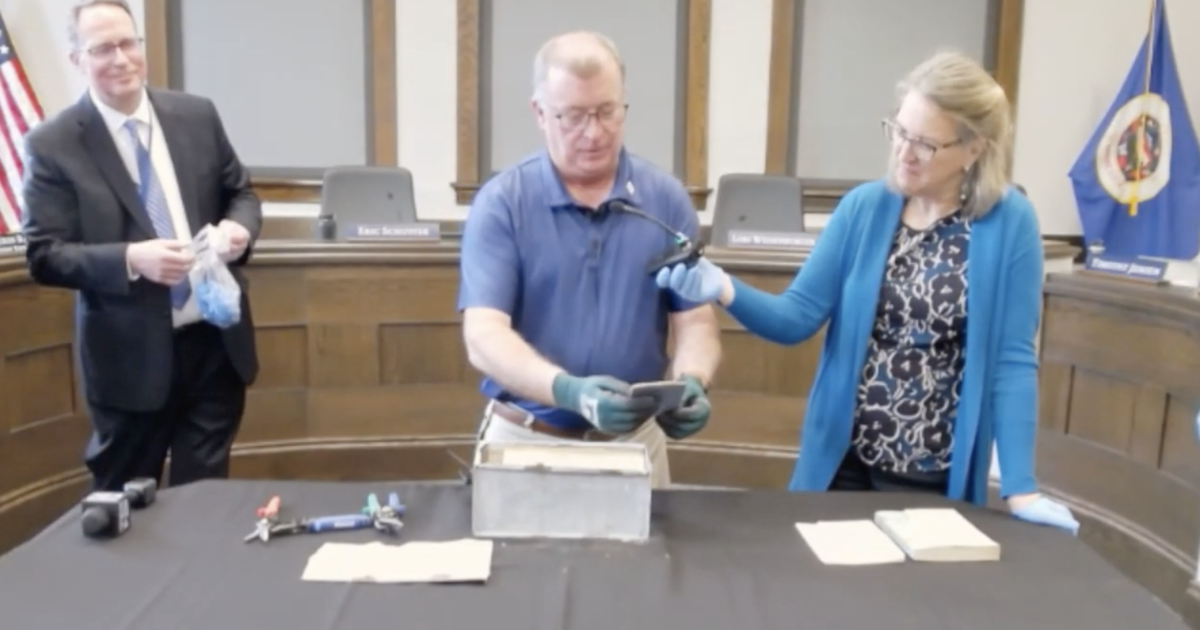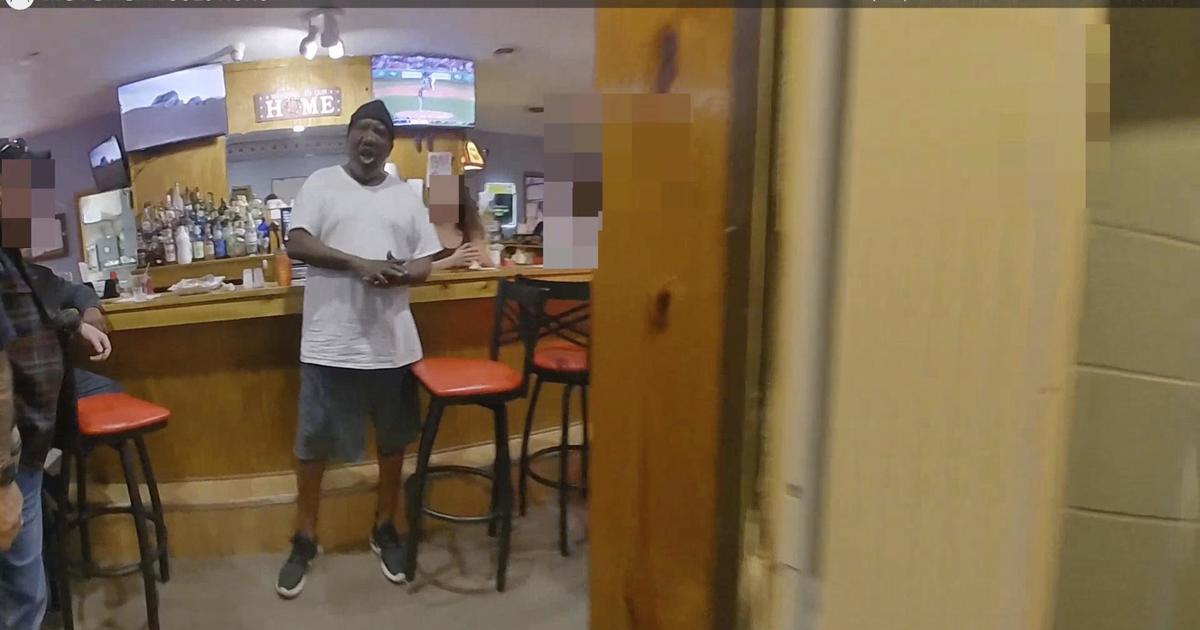Majority-Black school districts have far less money to invest in buildings — and students are feeling the impact
Cracked walls, mold, sewage backups, even the risk of electric shock. That's what students at Druid Hills High School outside Atlanta faced for years — and they wanted the world to see.
Chronic under-investment left school buildings and facilities there in disrepair. The problem got national attention after a video the students posted to social media went viral.
In the video, one student shows walls peeling from water damage. Another points to holes in the ceiling. One shows a sign warning students not to touch a metal pole in a classroom because of the risk of electrocution.
"This isn't really normal," said Harley Martz, a senior at Druid Hills who helped produce the video as a sophomore in 2022. "The bottom floor of our main building flooded … [students] had to relocate … and it was just very claustrophobic. I mean, those kids, I don't think they had class that week. I mean, it threw off just everyone's schedule."
As a new academic year begins, many students, like Martz, face barriers from the very walls of their school buildings, rather than their teachers or textbooks. A CBS News analysis of federal data found school districts with more Black students were able to invest far less money in buildings than majority-White districts — and often-unequal funding practices by state governments can make the problem worse.
7 miles apart, a world of difference
Druid Hills High is part of DeKalb County Public Schools, a district where CBS News found one of the starkest examples of unequal school building investment. Between 2015 and 2020, the DeKalb County School District invested about $961 in its buildings for each student enrolled.
Jack Cole, now a senior at Druid Hills, said the impact of under-investment was clear to the students.
"It's like there's no drive to want to be there and learn if I don't want to be in school in the first place," said Cole.
But while their school building is crumbling, others nearby are new, modern and innovative.
In comparison, City Schools of Decatur — a smaller, wealthier and majority-White public charter district completely encircled by the larger county district — invested more than $3,500 per student in buildings during those five years — and it shows.
School districts are almost entirely funded by local taxes, meaning wealthier districts have more money to invest in things like building improvements. Decatur's median household income is about $123,000, according to the latest U.S. Census estimates. DeKalb County's: less than $70,000.
The Decatur district's own website boasts of several recent building projects including restroom renovations, replacement blinds, upgraded air conditioning, new water bottle filling stations, and a new pottery kiln in an elementary school's art room — a stark contrast to what the Druid Hills students faced.
It's not the fault of wealthier school districts that they're able to invest more, said Mary Filardo, executive director of the 21st Century School Fund, who has studied inequity in capital school funding for decades.
But the system, Filardo says, has resulted in dramatic inequities around the country.
"There's no way to address the structural inequity that we have between school districts without addressing how we fund them," Filardo said.
A spokesperson for DeKalb County School District declined to comment on CBS findings; City Schools of Decatur did not respond to our requests for comment.
Unequal funding
Experts told CBS News state funding is needed to help make up gaps like these. But the opposite happened in the case of DeKalb and Decatur.
Federal data shows DeKalb County schools received about $132 per student from the state for "capital outlay" — money used to acquire land or renovate buildings — and other long-term spending. Decatur got $345 per student.
Majority-Black districts are often less funded — and as a result have less to invest in capital projects — than districts with more White students. From 2015-2020, DeKalb County schools had three times more Black students than Decatur, and six times more low-income students.
During that same period nationwide, districts that were at least 80% Black invested about half as much money in buildings than those that were less than 20% Black.
And it appears many states may be contributing to the problem by giving those majority-Black districts less money for capital outlay. Districts that were at least 80% Black got about a quarter of the money those with few Black students received.
Research has shown for years that there are significant overlaps between race and poverty in schools, and low-income districts were similarly impacted. CBS News' analysis of federal data showed those with more students who qualified for free or reduced-price lunch invested less in buildings, too.
Local funding, local disparities
School districts fund building projects through local taxes and so-called bond referenda — proposals to raise funds voted on by residents. State funding can help fill in the gaps, but current funding decisions often exacerbate inequalities.
"Part of what we have structured in this country is local control, which means we have many thousands of school districts," Filardo said.
For the most part, school districts — rich or poor — are "funded locally, particularly for school facilities," Filardo said.
"And so, if you're poor, if you have really old buildings, you may not have enough money within your district to afford the modernization of your buildings," Filardo added.
CBS News found examples like DeKalb and Decatur across the U.S.
CBS News Los Angeles found disparities between two adjacent districts; one had high percentages of Black and Hispanic students, while the other was mostly White.
Fontana Unified School District, which had more than 80% students of color and more than 92% of its children qualifying for free or reduced-price lunch, invested just $450 per student in buildings during those five years.
Etiwanda Schools, just one district to the west and with fewer students of color and fewer students in poverty, invested more than $1,350 per student.
On the East Coast, CBS News New York found the Brentwood Union Free School District — in a Long Island community where nearly all students were Black or Hispanic and qualified for financial aid — was able to invest just $25 per student on its facilities.
Another Long Island school district, Shoreham-Wading River Central School District, spent nearly $6,000 per student on buildings. Nearly all its students were White, and less than 5% were low-income enough to qualify for lunch assistance.
Even when districts have tried to give money to the schools that need it the most, it's often not enough.
Records obtained by CBS News Miami showed that Broward County Public Schools was estimated to need $2.9 billion for building improvements in 2014, but the district only asked for $800 million in its bond referendum that year. District officials told CBS News Miami they didn't ask for the full amount because of concerns voters might reject the proposal.
CBS News analyzed data showing how that $800 million was spent. It shows schools with more low-income students and Black students were budgeted more money for building improvements. But those poorer, majority-minority districts have been slower than wealthier, white districts to complete projects.
In Colorado, low-income districts are forced to compete for a limited pool of funding every year. Schools that don't make the cut can be left with dilapidated buildings and no way to improve them.
"What we have is a ticking time bomb and no solutions," the superintendent of one district told CBS News Colorado. "Because there is no financial support."
Real-world consequences
These disparities have a clear impact on learning, said Dr. Josh Sharfstein, M.D. who has done extensive research on these kinds of building inequities at Johns Hopkins University's Bloomberg School of Public Health.
"The physical condition of schools affects the health of children, and it affects the learning of children," he said. "Schools can make kids sick from asthma, from overheating, from leaks and mold, all kinds of things. Also, kids don't learn as well when they're in environments that aren't well-suited for learning."
Decades of research back up the assertion that the physical condition of schools impacts student performance.
A 2012 Miami-Dade study revealed that students in aging buildings score notably lower on tests, even after adjusting for things like income.
Researchers with The World Bank in 2019 found "providing access not only to school places but also to spaces that are safe and healthy positively affects pupils' academic outcomes."
And according to a 2022 report from the Center for American Progress, "upgrading and modernizing schools is not simply a matter of aesthetics but an essential element of learning."
In August 2023, CBS News toured Baltimore City School District's Benjamin Franklin High School, built in 1926 and one of the district's oldest buildings. Its age and lack of renovations were visible to anyone who looked.
The problem of not having air conditioning recently became all too clear. Just a few days after the school year began on August 28, the school was forced to send students home early as a heat wave smothered the city.
Other classrooms feature rotting and collapsed floors, holes in ceiling tiles, computers from the 1990s, and blackboards from the 1960s
"It's kind of hard, you know. You see the ceiling. It's messed up," one student said. "I mean, sometimes it gets crowded, and it might be hot, like some days ... it gets really hot."
Sharfstein said the inequities in Baltimore are rooted in history dating back to public school segregation — as are many other disparities CBS News found around the country.
"It's important to understand the roots in history of what we're seeing right now in the state of Maryland," Sharfstein said. "Really, for decades, Baltimore [City School District] has been disinvested. There have not been the same levels of investment in a city that is majority Black than in the rest of the state. And the consequences of that are physically manifest in school buildings."
The problem only worsens as each year passes without enough investment, according to Sharfstein.
"Because there have been such disproportionate shares of political power, people who are low income, often minority communities living near those schools, their voices haven't been heard," said Sharfstein. "I think every state should be asking the question of how to make funding decisions fair for schools and children."
CBS News Chicago: A Harvey school was falling apart, then officials took action without new taxes
New approaches
Recognizing the problem in 2020, Maryland state lawmakers started to fix the state's school funding model.
Overriding a veto by the governor, the General Assembly passed the "Blueprint for Maryland's Future," legislation that increases annual education funding by $3.8 billion within the next 10 years. That will include an additional $4,000 going to schools for each student enrolled.
As part of the "Blueprint," lawmakers constructed the "Built to Learn" Act specifically to help fund building construction and renovation, including $400 million specifically targeted towards building and repairing schools in lower-income and minority districts.
"We are investing in a more equitable system across the state of Maryland than almost any other state in the country," said State Senate President Bill Ferguson, who represents Baltimore in Maryland's Capitol.
"I think Maryland has done a great job of really trying to make a more equitable funding system. We don't just solely rely on the property tax in Maryland," Ferguson said. "We use state dollars so that wealthier jurisdictions put in more where they have the ability. The state steps in for the lower income jurisdictions to make sure that we can fund appropriately."
A handful of other states are trying a similar approach.
"I think every state needs to revisit how they're doing," said Stephanie Smith, a member of Maryland's House of Delegates. "I think we can't always wait for just a change in administration."
"From what I've seen just going around the city and the state, it is working," said Smith who represents Baltimore City and serves on the House's Appropriations Committee. "People are putting these dollars to use."
Whether students are at school districts with explosive growth and new buildings or in districts with old, deteriorating buildings, "at every level, the student still deserves to be in a safe, healthy building that supports their learning," said Smith.
But critics say under Maryland's "Blueprint," more money needs to be sent even faster to school districts in need.
Sharfstein was so concerned about the inequities that still exist even in Maryland's new funding approach that he sent a letter to state officials writing that the current method "does not appear to be fair to those students ... disproportionately low income, Black and Hispanic... who go to school in aging facilities with major infrastructure problems."
The money won't come soon enough for students already attending Franklin High who will graduate before any renovation or change comes to the high school.
"We've really tried to do the best we can to make a more wealth equalized system," said Ferguson. "We still have a ways to go."
Ross Palombo, Jennifer Bisram and Joe Gorchow contributed to this report.




